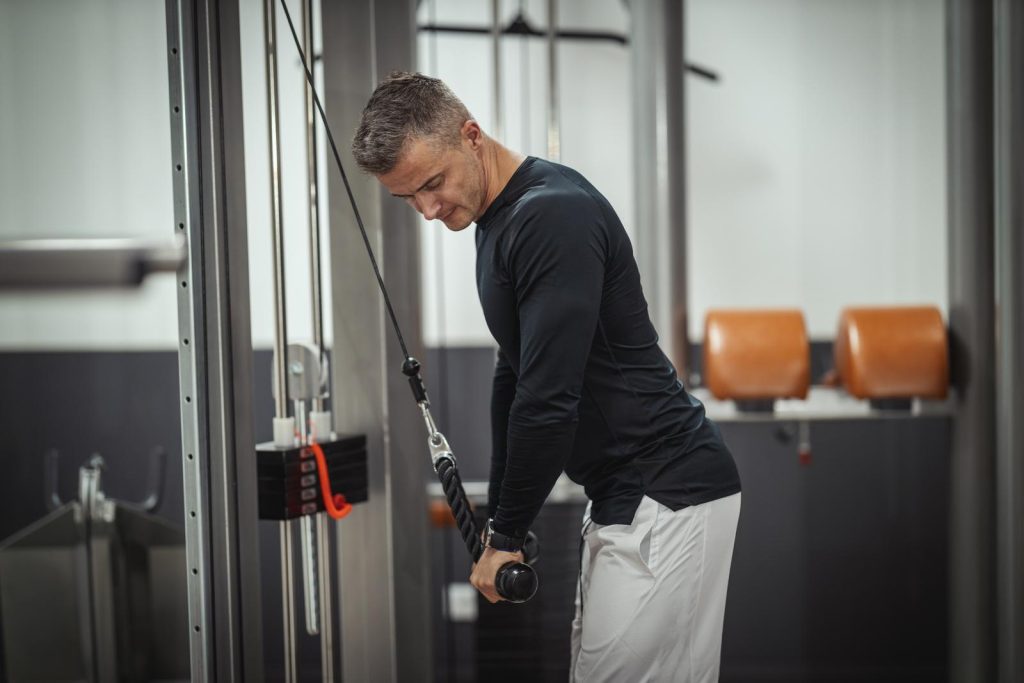Are you tired of having weak and flabby triceps? Do you want to build bigger and stronger arms? Well, you’re in luck because we have some expert tips and techniques to help you achieve those impressive triceps you’ve always dreamed of.
When it comes to building muscle, many people focus on their biceps or chest, forgetting about the importance of developing strong triceps. The triceps are actually the largest muscle group in your arms and play a crucial role in performing pushing exercises like bench presses and push-ups. Neglecting them can prevent you from reaching your full potential in the gym.
If you’re ready to take your arm gains to the next level, it’s time to learn how to properly target and train your triceps. In this article, we will discuss effective exercises, proper form, and key strategies to help you get bigger triceps. Say goodbye to those weak arms and hello to a stronger, more defined upper body.
Contents
How To Get Bigger Triceps: The Fundamentals Of Triceps Training
Whether you’re a beginner or a seasoned gym-goer, these tips and techniques will help take your triceps workout to the next level. Let’s dive in!
Understand The Anatomy Of The Triceps
Before you start training your triceps, it’s important to have a basic understanding of the anatomy of these muscles. The triceps consist of three heads – the long head, lateral head, and medial head. Each head has a specific function and contributes to the overall strength and appearance of your triceps.
Choose The Right Exercises
There are several effective exercises that target the triceps. Some of the most popular ones include tricep dips, tricep pushdowns, overhead tricep extensions, and close-grip bench presses. It’s important to choose exercises that target all three heads of the triceps to ensure balanced development.
Start With The Proper Form
When performing triceps exercises, it’s crucial to maintain proper form to maximize effectiveness and prevent injuries. Make sure to keep your elbows close to your body, engage your core for stability, and avoid any unnecessary swinging or jerking movements. Start with lighter weights or bodyweight exercises until you feel comfortable with your form.
Gradually Increase Intensity And Resistance
As you become stronger, it’s important to gradually increase the intensity and resistance of your triceps exercises. This can be done by adding weights, using resistance bands, or performing more challenging variations of the exercises. Progressive overload is key to continually challenge your muscles and stimulate growth.
Include Variety In Your Training
To prevent plateaus and keep your triceps training interesting, it’s important to include a variety of exercises in your routine. This could include different variations of the exercises mentioned earlier, as well as incorporating other triceps-specific exercises such as diamond push-ups or triceps kickbacks. Mixing up your workouts will keep your muscles guessing and prevent boredom.
Don’t Forget About Rest And Recovery
While it’s important to challenge your triceps with regular training, it’s equally important to allow them time to rest and recover. Overtraining can lead to muscle imbalances and an increased risk of injury. Aim for at least one full rest day between triceps workouts and listen to your body if you feel excessive fatigue or soreness.
Maintain A Balanced Workout Routine
Remember that triceps training is just one component of a well-rounded workout routine. To achieve optimal results, make sure to include exercises for other muscle groups, such as the biceps, chest, shoulders, and back. A balanced approach will not only improve overall strength but also help create a well-proportioned upper body.
How To Get Bigger Triceps With Dumbbells
Designing an effective triceps workout routine requires a combination of exercises that target the triceps from different angles and intensities. Here’s a well-rounded triceps workout routine that you can follow. Remember to warm up before starting the workout and cool down afterward.
Warm-up: Start with 5-10 minutes of light cardio to increase blood flow to your muscles and do some dynamic stretches for your arms and shoulders.
Triceps Workout Routine:
Close Grip Bench Press:
- Target: Overall triceps development.
- How to do it: Lie flat on a bench with your hands placed closer than shoulder-width apart on the barbell. Lower the bar down to your chest, keeping your elbows close to your body, and then push it back up.
Triceps Dips:
- Target: All three heads of the triceps.
- How to do it: Use parallel bars or dip bars. Lower your body by bending your elbows until your upper arms are parallel to the ground, then push yourself back up.
Overhead Triceps Extension:
- Target: Focuses on the long head of the triceps.
- How to do it: Stand or sit with a dumbbell in both hands. Raise the dumbbell overhead and then bend your elbows to lower the weight behind your head. Extend your arms back up.
Triceps Pushdown:
- Target: Mainly the lateral head of the triceps.
- How to do it: Use a cable machine with a straight bar attachment. Stand with feet shoulder-width apart, and push the bar down until your arms are fully extended, then return to the starting position.
Skull Crushers (Lying Triceps Extensions):
- Target: Emphasizes the long head of the triceps.
- How to do it: Lie on a bench with a barbell or dumbbells in hand. Lower the weight toward your forehead by bending your elbows, then extend your arms back up.
Diamond Push-ups:
- Target: Puts more emphasis on the triceps than regular push-ups.
- How to do it: Get into a push-up position but place your hands close together, forming a diamond shape with your thumbs and index fingers. Lower your chest toward your hands and then push back up.
Workout Tips:
- Perform 3-4 sets of each exercise.
- Aim for 8-12 reps per set for muscle hypertrophy (increasing muscle size) and 12-15 reps per set for muscular endurance.
- Rest for about 60-90 seconds between sets.
- Focus on maintaining proper form throughout each exercise to prevent injuries and maximize results.
- It’s essential to progressively increase the weight or intensity over time to continue challenging your triceps and promoting growth.
Cool-down:
Finish your triceps workout with static stretches for your triceps and shoulders to improve flexibility and reduce post-workout muscle soreness.
Remember that everyone’s fitness level is different, so adjust the intensity and weight based on your capabilities. If you’re new to strength training or have any health concerns, consider consulting a fitness professional before starting a new workout routine.
Recommended Sets, Reps, And Weights For Triceps Exercises
he recommended sets, reps, and weights for triceps exercises can vary depending on your fitness level, training goals, and the specific exercise you’re performing. Below are some general guidelines you can follow, but it’s essential to listen to your body and adjust according to your individual needs and capabilities:
Sets And Repetitions (Reps):
- For Strength: Aim for lower reps (e.g., 4-6) with higher weight. This helps in building raw strength in the triceps.
- For Hypertrophy (Muscle Growth): Target moderate reps (e.g., 8-12) with moderate weight. This range is commonly associated with muscle growth.
- For Endurance: Focus on higher reps (e.g., 15-20) with lower weight. This improves muscular endurance.
Weight Selection:
- For Strength: Use a weight that allows you to perform the specified reps with proper form, but it should be challenging enough that the last rep feels tough to complete.
- For Hypertrophy: Choose a weight that challenges you to complete the target reps while maintaining proper form.
- For Endurance: Use a lighter weight that allows you to complete the higher number of reps without excessive strain.
Rest Between Sets:
- For Strength: Take longer rest periods (2-3 minutes) between sets to allow for optimal recovery.
- For Hypertrophy: Shorten the rest periods (1-2 minutes) to maintain a higher level of muscle tension during the workout.
- For Endurance: Keep rest periods relatively short (30 seconds to 1 minute) to maintain a higher heart rate and muscular fatigue.
Sample Triceps Workout: Here’s an example of a triceps workout routine that incorporates different sets, reps, and weights for each goal.
Close Grip Bench Press:
- Strength: 3-5 sets x 4-6 reps (heavy weight)
- Hypertrophy: 3-4 sets x 8-10 reps (moderate weight)
- Endurance: 2-3 sets x 12-15 reps (lighter weight)
Triceps Dips:
- Strength: 3-5 sets x 4-6 reps (add weight if needed)
- Hypertrophy: 3-4 sets x 8-12 reps (bodyweight or add weight)
- Endurance: 2-3 sets x 15-20 reps (bodyweight)
Overhead Triceps Extension:
- Strength: 3-5 sets x 4-6 reps (heavy dumbbell or barbell)
- Hypertrophy: 3-4 sets x 8-10 reps (moderate dumbbell or barbell)
- Endurance: 2-3 sets x 12-15 reps (light dumbbell or cable)
Triceps Pushdown:
- Strength: 3-5 sets x 4-6 reps (heavy cable attachment)
- Hypertrophy: 3-4 sets x 8-12 reps (moderate cable attachment)
- Endurance: 2-3 sets x 15-20 reps (light cable attachment)
Skull Crushers (Lying Triceps Extensions):
- Strength: 3-5 sets x 4-6 reps (EZ bar or barbell with heavy weight)
- Hypertrophy: 3-4 sets x 8-10 reps (EZ bar or dumbbells with moderate weight)
- Endurance: 2-3 sets x 12-15 reps (dumbbells with lighter weight)
Diamond Push-ups:
- Strength: 3-5 sets x 4-6 reps (add weight if needed)
- Hypertrophy: 3-4 sets x 8-12 reps (bodyweight or add weight)
- Endurance: 2-3 sets x 15-20 reps (bodyweight)
Remember to warm up properly before starting your triceps workout and perform each exercise with proper form to reduce the risk of injury. As you progress, you can adjust the weights and reps to keep challenging your triceps and continue making gains.
If you’re new to weight training, it’s a good idea to work with a fitness professional to ensure you’re using correct form and appropriate weight for your fitness level.
Common Triceps Training Injuries And How To Prevent Them
Elbow Tendonitis
Elbow tendonitis, also known as tennis elbow, can be prevented by warming up before exercising and gradually increasing the intensity of triceps workouts. It’s important to use proper form and technique to avoid straining the tendons, and if pain occurs, rest and medical attention may be necessary.
Triceps Strain
A triceps strain occurs when the muscles or tendons in the triceps are stretched or torn. To prevent a triceps strain, gradually increase the intensity and duration of triceps workouts, use proper form and technique, and incorporate rest and recovery days into your training schedule.
Bicep Tendonitis
Bicep tendonitis can cause triceps pain and discomfort. To prevent this injury, it is important to warm up properly, gradually increase the intensity of triceps workouts, and avoid excessive strain on the biceps muscles. Rest and seek medical advice if experiencing pain or discomfort.
Muscle Imbalances
Muscle imbalances occur when some muscles are stronger than others, leading to an increased risk of injury. To prevent imbalances in the triceps, it’s important to have a balanced exercise routine that targets all major muscle groups and focuses on proper form and technique.
Overtraining
Overtraining in the triceps can lead to excessive stress and an increased risk of injury. To prevent this, it’s important to incorporate rest and recovery days into your training schedule for optimal muscle growth and strength.
Conclusion
Getting bigger triceps is possible with a balanced and consistent approach. Start by warming up properly, use proper form and technique, gradually increase the intensity of your workouts, and incorporate rest days to allow for muscle recovery. With these tips in mind, you can get on your way to bigger and stronger triceps!




